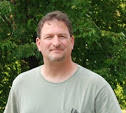
Andromeda Galaxy (M31) is the bright fuzzy object (left side of picture).
You may ask: "What's needed to become involved in backyard astronomy ?"
Short Answer:
A star chart, your eyes and clear, dark skies.
Long Answer:
Binoculars or a telescope are needed, especially if you want to view fine details of solar system or deep space objects.
What's the Attraction to Amateur Astronomy?
Many amateur astronomers like to keep it simple and merely observe the wonders the heavens have to offer, while others like to photograph their observations. Others still spend their time studying certain classes of objects, (i.e. - The moon, planets, nebula, star clusters, galaxies, binaries, etc...). I've even met astronomers that dedicate their time to the study of 'one' object.
What's the Cost ? A few hundred to several thousand dollars.
Some are satisfied buying a $300 90mm telescope, and occasionally viewing the moon and planets. Others spend tens of thousands of dollars on mini-Hubble observatories that can rival some professional observatories. The cost reflects what you want to do.
If you plan to observe the heavens one or more night a month, purchase a telescope from a reputable dealer (Celestron, Meade, Orion or Vixen) and buy a motorized mount that has GOTO capability. Make sure the Optical Tube Assembly (OTA) has an aperture of at least 125mm. Stay away from department store junk that measures telescope performance as 40x or 120x power. They are not quality instruments and you will quickly lose interest in astronomy.
Here's the equipment I use:
- Meade ETX-125EC Telescope with Meade #884 Field Tripod
- Autostar #497 Handbox
- Meade Electronic Controller
-Meade Series 4000 1.25" Eyepieces (6, 9, 12.5, 15, 20, 26, 32 and 40mm)
- Nikon D80 D-SLR camera
- Black & Decker "JumpStart" portable battery starter.
Astrophotography techniques:
Prime Focus: I use the telescope's OTA as the lens on my D80 camera. The connection is made using a Nikon T-mount and Meade T-Adapter.
Piggy Back: I mount my D80 onto the ETX-125EC's OTA and use a standard camera lens to photograph a desired region of the heavens. This method works well I want to track an object in space for long exposure astrophotography.
Wide Field (with Tripod): The D80 is mounted onto a camera tripod. The drawback here is that exposure times for each photo must be short (5 - 15 seconds or less), otherwise noticable star trails can be seen. Here's my basic rule of thumb:
50mm Lens - Star trails noticable after 15 seconds of exposure.
100mm Lens - Star trails noticable after 8 seconds of exposure.
200mm Lens - Star trails noticable after 5 seconds of exposure.
Check http://www.astropix.com/ for several astrophotography tips and techniques. (Hit the back button to return to my BLOG)
Happy Star Gazing!
StarPilot


2 comments:
Good dispatch and this mail helped me alot in my college assignement. Thanks you for your information.
KAS Paper Systems are manufacturers of high quality mailing machines, paper handling systems and print finishing equipment. KAS Paper Systems product range includes
mailing equipment
Post a Comment